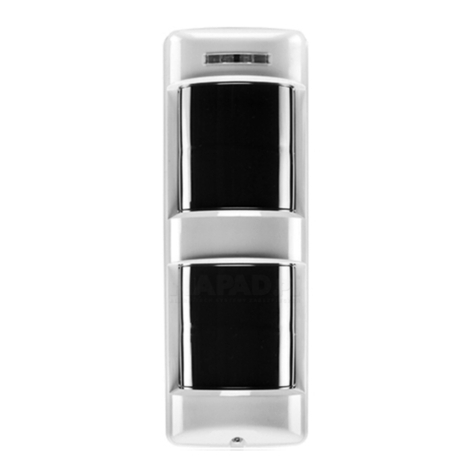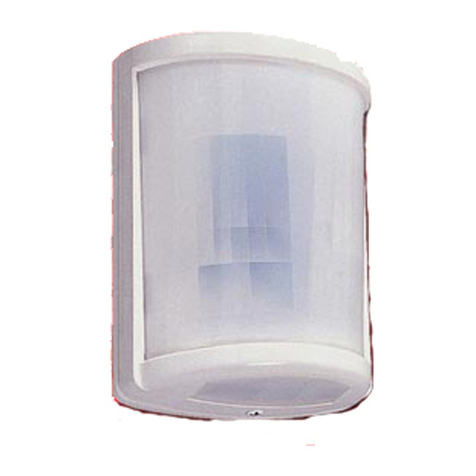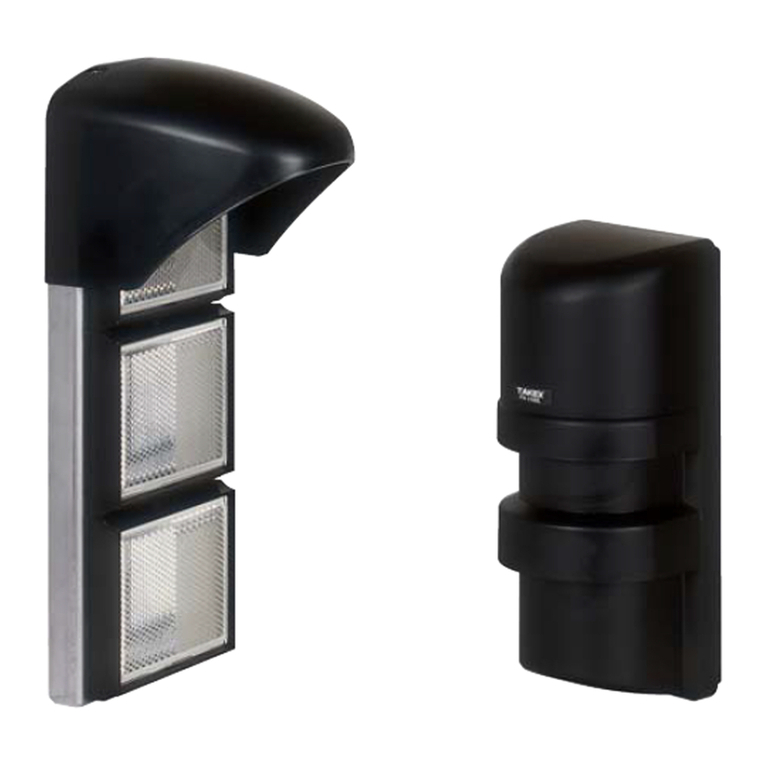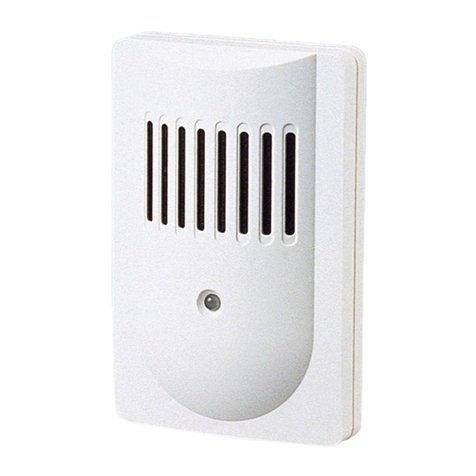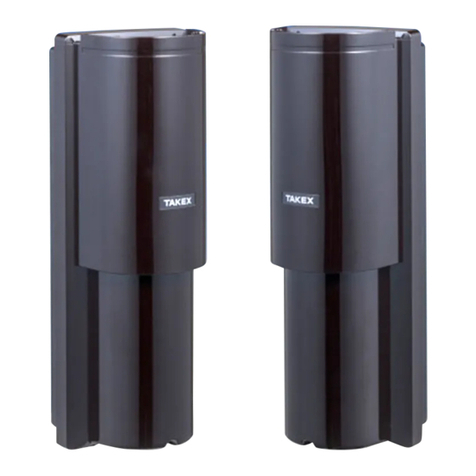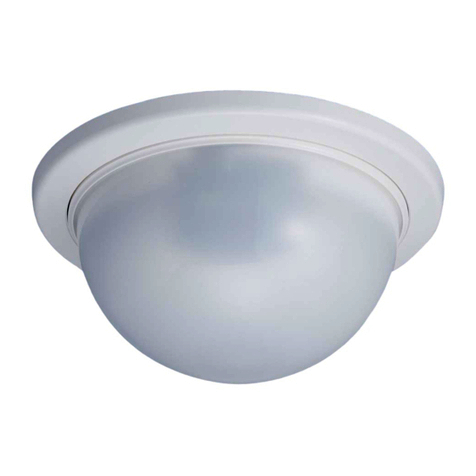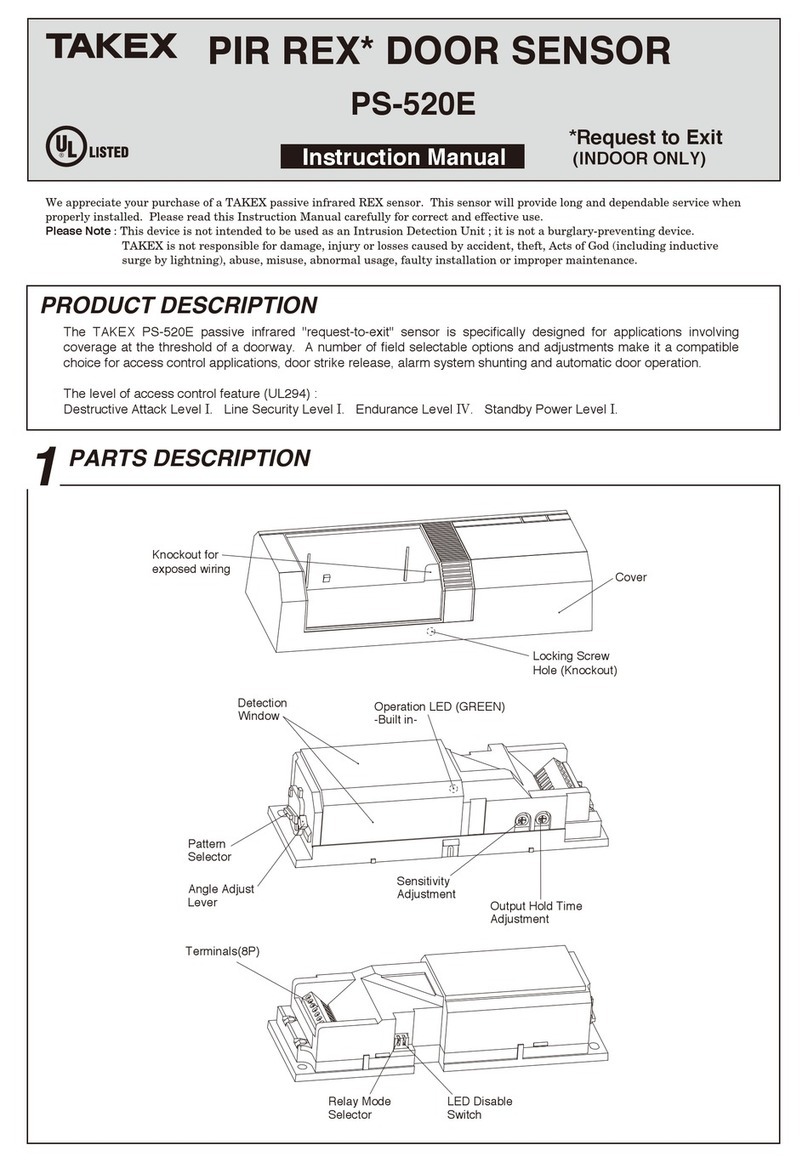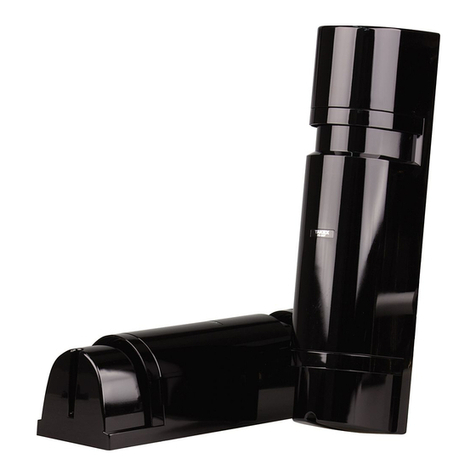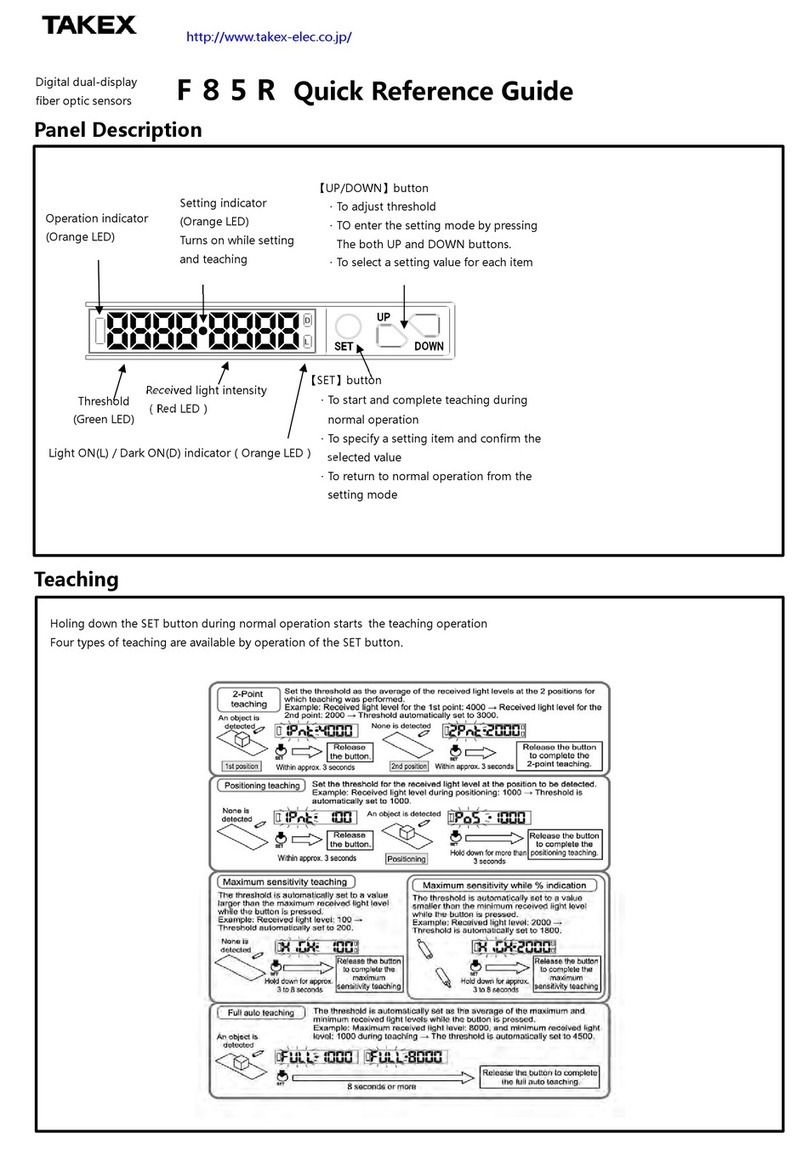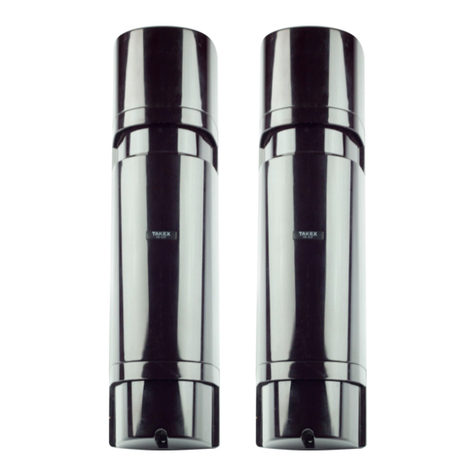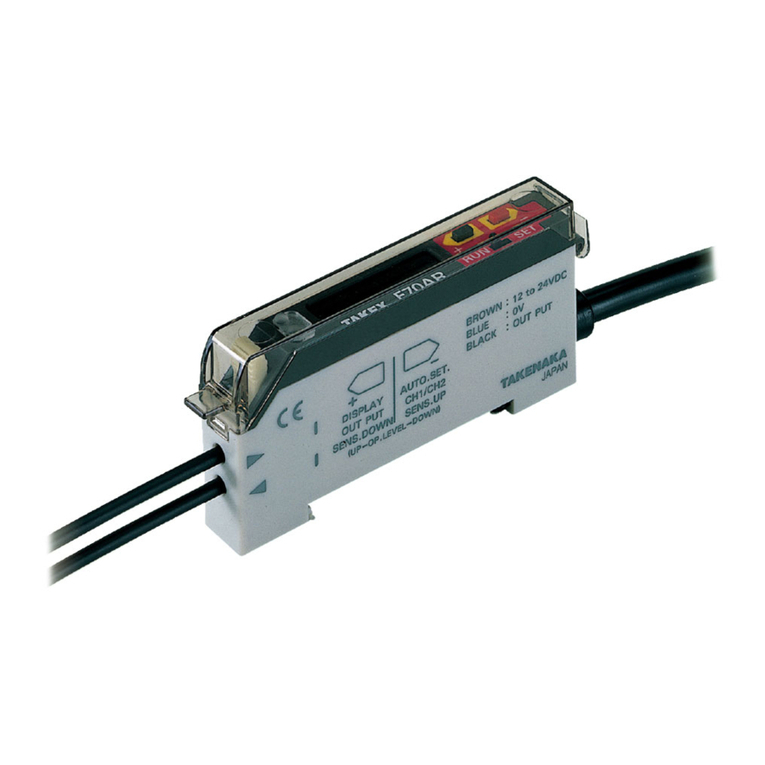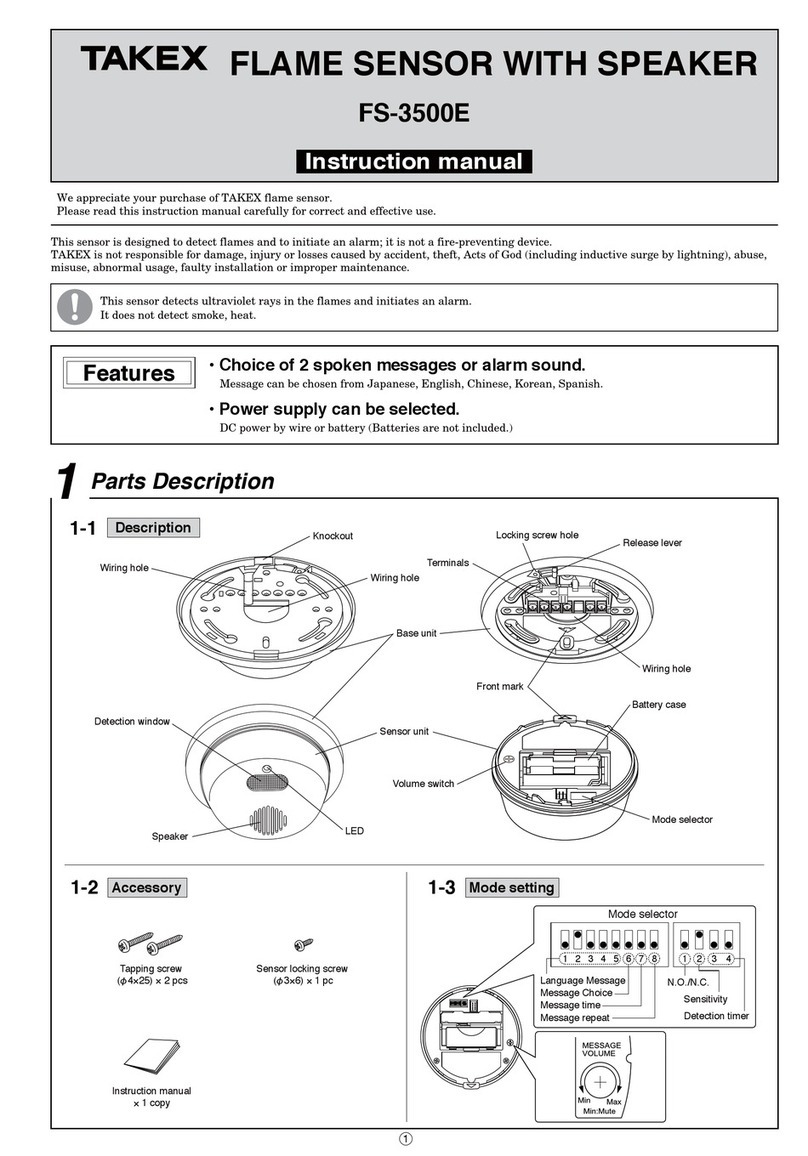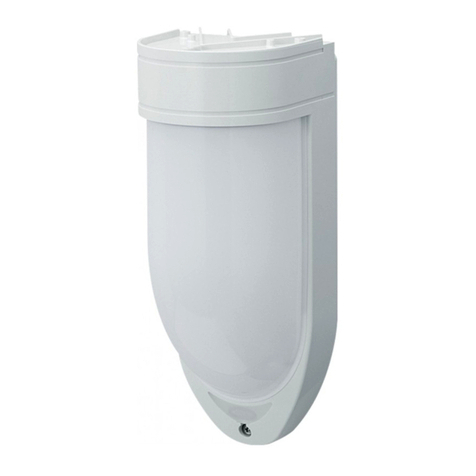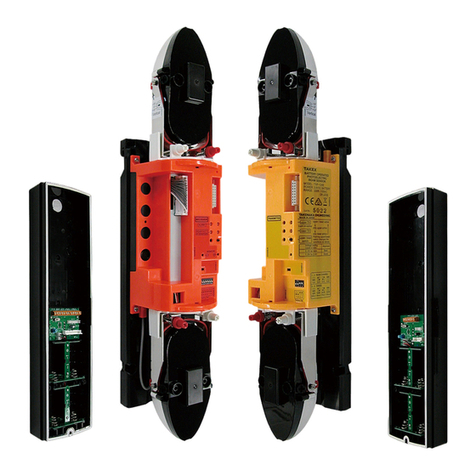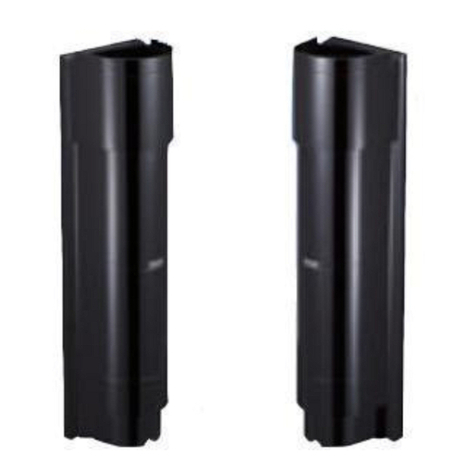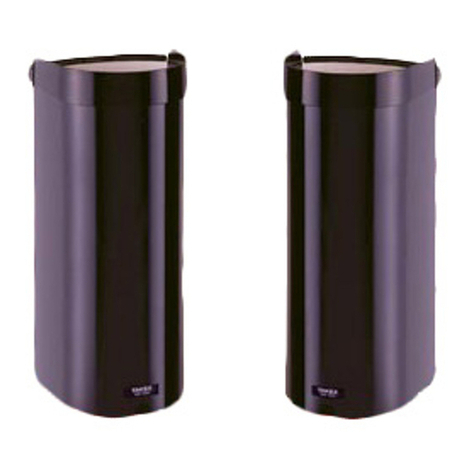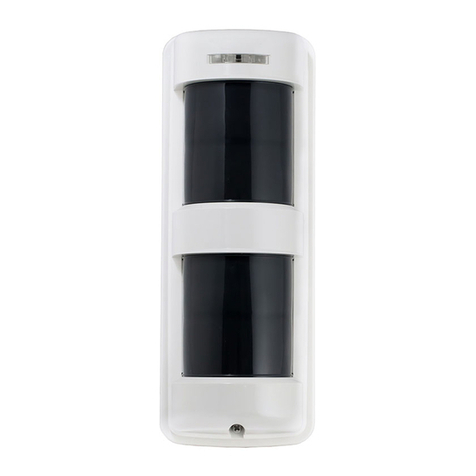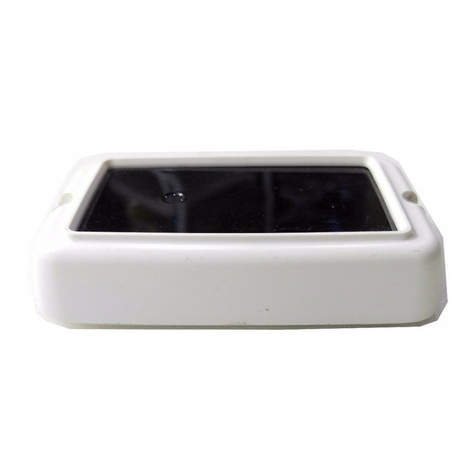
7TROUBLESHOOTING
8EXTERNAL DIMENSIONS
9
SPECIFICATIONS
Symptom Possible cause Remedy
1) No power supply.
2) Bad wiring connection or broken wire, short.
3) Beam is reflected on another object and sent into the receiver.
LIMITED WARRANTY
1) Turn on the power supply.
2) Check wiring.
3) Remove the reflecting object or change beam direction.
Alarm LED does not light
when the beam is broken.
Alarm LED continues to
light.
1) Beam alignment is out.
2) Shading object between sensor and reflector.
3) Sensor cover or reflector are soiled.
1) Check and adjust again.
2) Remove the shading object.
3)
Clean the reflector with a soft cloth, or wash the cover with water.
1) Bad wiring connection.
2) Change of supply voltage.
3) Shading object between sensor and reflector.
4) A large electric noise source, such as power machine, is located
nearby sensor.
5) Unstable installation of sensor and reflector.
6) Sensor cover or reflector are soiled.
7) Improper alignment.
8) Small animals may pass through the beams.
1) Check again.
2) Stabilize supply voltage.
3) Remove the shading object.
4) Change the place for installation.
5) Stabilize.
6)
Clean the reflector with a soft cloth, or wash the cover with water.
7) Check and adjust again.
8) Set the response time longer. (Do not use this setting
where an intruder can run at full speed through the beam.)
Intermittent alarm
1PARTS DESCRIPTION
SENSOR REFLECTOR
Terminals
Self-tapping
screws
φ4�30:2
Response time
adjustment
Horizontal
adjustment
Vertical
adjustment
screw
COVER MOUNTING PLATE
Lens
(Transmitter)
View finder
Lens
(Receiver)
PRODUCT DESCRIPTION
This beam sensor contains a transmitter receiver and reflector.
As illustrated, an infrared beam, projected by the transmitter, is reflected back to the receiver.
The protection loop is formed along the path from the transmitter to the reflector and back to the receiver.
When this protection loop is interrupted, the receiver will initiate an alarm.
*This beam sensor requires cable to the sensor unit
end only, and reflects an infra-red light beam off a
reflector unit (supplied). It is suitable for monitoring
entrances, gateways, driveways etc where cabling to
both ends is a problem.
*This beam sensor can be used internally or
externally, with a maximum range between the
sensor unit and reflector of 15m internally, or 11m
externally.
*Beam alignment can be adjusted at the sensor side
only.
ACCESSORY OPTION PARTS
Thank you for purchasing our photoelectric beam sensor.
This sensor will provide long and dependable service when properly installed.
Please read this Instruction Manual carefully for correct and effective use.
Please note : This sensor is designed to detect intrusion and to initiate an alarm ; it is not a burglary-preventing device.
TAKEX is not responsible for damage, injury or losses caused by accident, theft, Acts of God ( including inductive
surge by lightning ), abuse, misuse, abnormal usage, faulty installation or improper maintenance.
●Specifications are subject to change without notice.
5ALIGNMENT AND OPERATION
6RESPONSE TIME
Adjust response time as follows. The unit does not detect a passing object faster than the response time setting. If the
response time is set longer, the unit does not detect human beings. Adjust to a little longer response time in a site where large
objects such as birds, newspaper, or falling leaves may pass through the beam path.
●Unreasonably long response times may fail to detect a human being.
Response 0.05 sec. Response 0.3 sec. Response 0.7 sec.
Response time adjustment
Response time
(sec.)
(0.3)
0.7
0.05 (standard) Run at full speed Walk with quick steps Walking
Note :
Attenuation sheet
View finder View finder
Horizontal
adjustment
Vertical adjustment screw
Clockwise : Upward
Counterclockwise : Downward
InstructionManual
PR-11BE : OUTDOOR 1 to 11m(3.3 to 36ft.)
: INDOOR 1 to 15m(3.3 to 49ft.)
Knockout
Knockout
□12mm×7mm
(□0.47"×0.28")
□12mm×7mm
(□0.47"×0.28")
2-φ4mm
(φ0.16") Wiring lead
Middle point
of the sensor
lenses
減衰シート
Beam level (outdoor, indoor)
Best
Good
Re-adjustment
Monitor output voltage
2.6V or more
1.4to2.6V
less than 1.4V
20mm(0.79")
83.5mm
(3.29")
14.5mm
(0.57")
44mm
(1.73")
12mm
(0.47")
73mm(2.87") 71.5mm(2.81")
25mm
(0.98")
170mm(6.69")
③
①
PHOTOELECTRIC BEAM SENSOR
Transmitter
Sensor
Receiver
Reflector
Monitor jack
Alarm LED
Model
Detection system
Protection distance
Supply voltage
Current consumption
Alarm output
Tamper output
Response time
Alarm LED
Attenuation LED
Functions
Ambient temperature range
Mounting positions
Wiring
Weight
Appearance
PR-11BE
Near infrared beam interruption system (reflective)
Outdoor 1 to 11m (3.3 to 36')
Indoor
1 to 15m (3.3 to 49')
10.5V to 30V DC (Non-polarity)
55mA or less
Dry contact relay from N/O-N/C
Contact capacity : 30V (AC/DC) 0.5A or less
Relay operation : Interruption time (minimum 2 secs)
Dry contact relay 1b (N/C)
Action : Activated when cover is detached.
Contact capacity : 30V (AC/DC) 0.5A or less
0.05sec to 0.7sec. (Adjustable by potentiometer)
Red LED
ON : when an alarm is initiated
Red LED
ON : when beam is attenuated
Monitor output
-25℃to +60℃(-13°F to +140°F)
Outdoor/Indoor
Terminals
Sensor : 430g (15oz) Reflector : 190g (6.7oz)
Sensor : Resin (wine red)
Reflector : Resin (clear / black)
Alarm LED
Attenuation LED
BEAM ALIGNMENT
①With the cover detached, face the sensor lenses towards
the reflector.
Adjust the angle of the sensor unit vertically and
horizontally by looking through the view finder placed
between the sensor lenses.
Adjust it until the center of the reflector can be seen in the
middle of the view finder.
②Supply power to the sensor.
When the sensor and reflector are properly installed at the
same height, alarm LED will remain OFF.
③After confirming that the alarm LED is OFF, place the
attenuation sheet on the optics of the sensor and check if
the attenuation LED is OFF.
Please note that there are two types of attenuation sheets.
(indoor use and outdoor use)
④If the attenuation LED lights, make adjustment again
until it turns OFF.
⑤Fine tuning should be done by monitoring the output
voltage using a volt meter.
⑥Remove the attenuation sheet after aligning the reflector
beam (and retain for future use) before fitting the front
cover.
・The above voltage shows the monitor output when
the lenses are covered by the attenuation sheet.
・Using the attenuation sheet and a voltmeter ensures
optimum performance of the sensor.
OPERATION CHECK
・After installing the sensor and making the alignment
adjustment, check the operation of the sensor, with its
cover attached, by looking at the alarm LED on the sensor.
①Make sure that the alarm LED is OFF.
②When the infrared beam is interrupted, the alarm LED
lights.
It indicates that the operation is normal.
The relay operates during the interruption time for a
minimum of 2 seconds.
③Walk through the infrared beam between the sensor and
the reflector and make sure that the alarm LED lights up
and then goes off.
Note :
(See the table below.) until obtaining the peak voltage.
Make sure the light turns off(②)
Make sure the light turns off(③,④)
Reflector
Sensor
REFLECTOR
SENSOR
Alarm LED
Volt meter
Attenuation
LED
Check the operation of the unit once a week.
If the cover becomes soiled, wash it with water.
Never clean it with a cloth otherwise it could damage the photocatalytic coating applied to the sensor cover.
The coating is designed to prevent attenuation of the infrared caused by waterdrops from torrential rain.
*Do not clean the cover with a cloth.
〈Daily check〉
〜〜〜〜〜〜〜〜〜〜〜〜〜〜〜〜〜〜〜〜〜〜〜〜
〜〜〜〜〜〜〜〜〜〜〜〜〜〜〜〜〜〜
TAKEX products are warranted to be free from defects in material and
workmanship for 12 months from original date of shipment. Our warranty does
not cover damage or failure caused by natural disasters, abuse, misuse,
abnormal usage, faulty installation, improper maintenance or any repairs other
than those provided by TAKEX. All implied warranties with respect to TAKEX,
including implied warranties for merchantability and implied warranties for
fitness, are limited in duration to 12 months from original date of shipment.
During the Warranty Period, TAKEX will repair or replace, at its sole option,
free of charge, any defective parts returned prepaid. Please provide the model
number of the products, original date of shipment and nature of difficulty being
experienced. There will be charges rendered for product repairs made after our
Warranty Period has expired.
Self-tapping
screws
φ4×30 : 3
Push rivet
Pole bracket
: 2pcs.
Pole mounting plate
: 2pcs.
Attenuation sheet
for outdoor
Attenuation sheet
for indoor
BP-60A BL-11
Pole attachment L fittings
3-φ4mm
(0.16”)
19.5mm(0.77”)
100mm(3.94”)
93mm(3.66”)
226mm(8.90”)
126.8mm(4.99”)
58mm
(2.28”)
101mm(3.98”)
6mm
(0.24”)
Center of the reflector
※After adjustment, remove the attenuation sheet.
①⑥⑤
No.05-097 B9035
In Japan
Takex America Inc.Takenaka Engineering Co., Ltd.
https : // www. takex-eng. co. jp /
Takex America Inc.
https : // www. takex. com
Takex Europe Ltd.
https : // www. takex. com
In the U.S. In the U.K.
In Australia
Aviary Court, Wade Road,
Basingstoke, Hampshire. RG24 8PE, U.K.
Tel : (+44) 01256-475555
Fax : (+44) 01256-466268
4/15 Howleys Road, Notting Hill,
VIC, 3168
Tel : +61 (03) 9544-2477
Fax : +61 (03) 9543-2342
https : // www. takex. com
83-1, Gojo-Dori, Sotokan Nishi-iru, Higashino,
Yamashina-ku, Kyoto 607-8156, Japan
Tel : 81-75-501-6651
Fax : 81-75-593-3816
151, San Zeno WAY
Sunnyvale, CA 94086, USA
Tel : 408-747-0100
Fax : 408-734-1100

